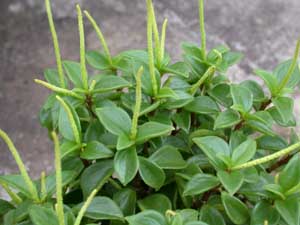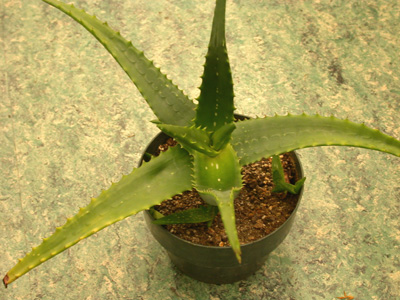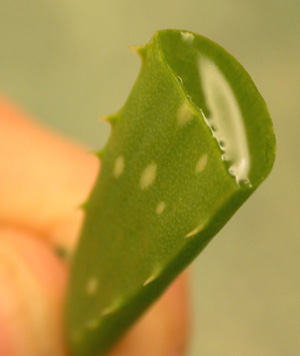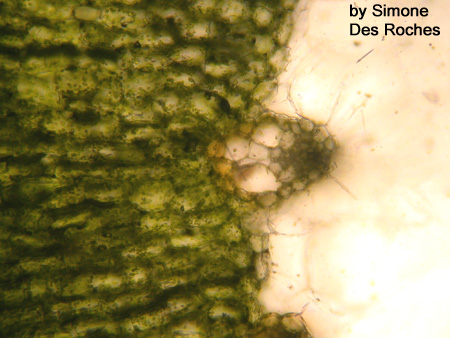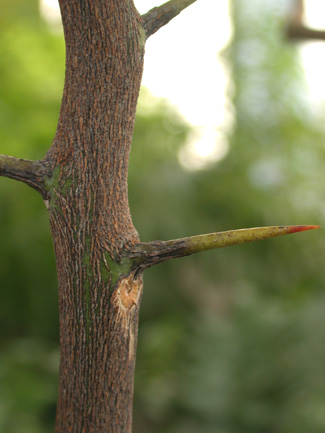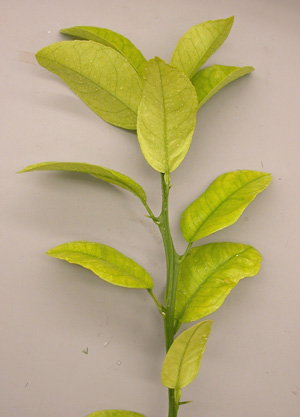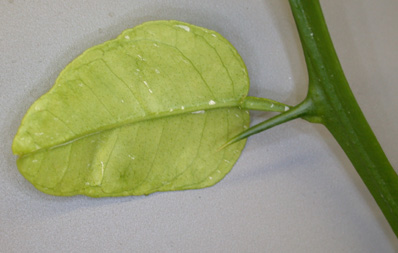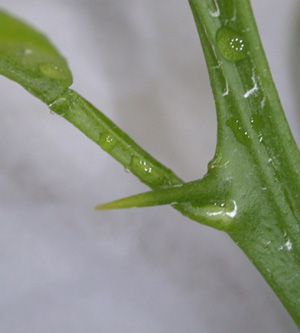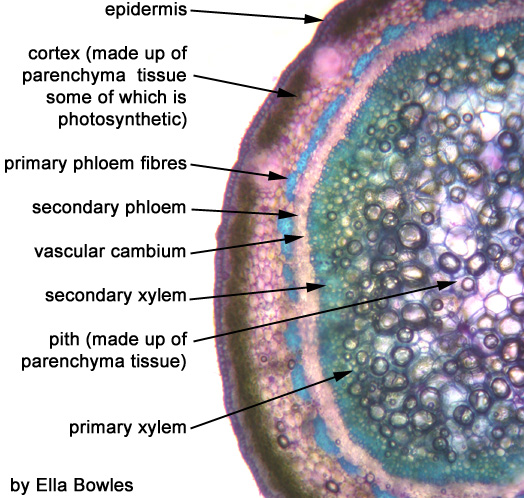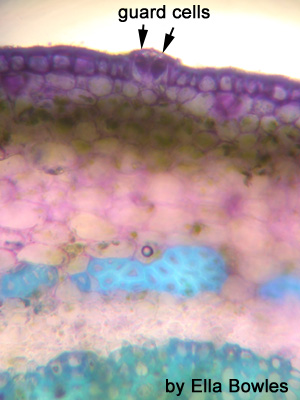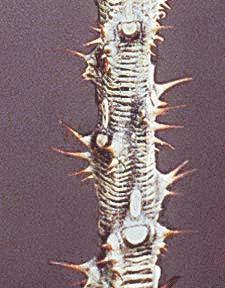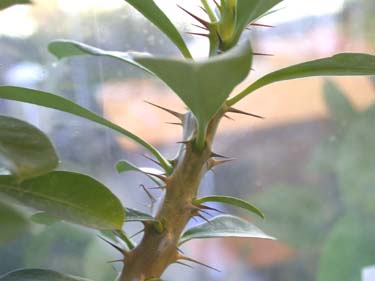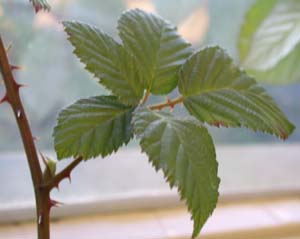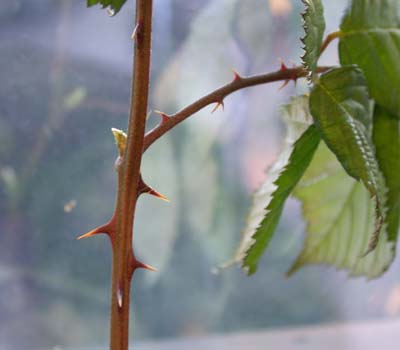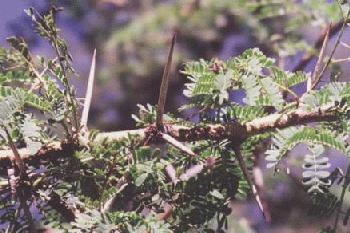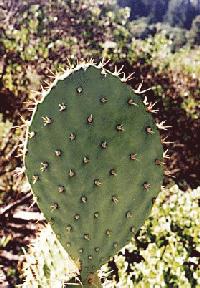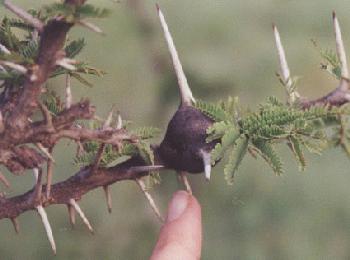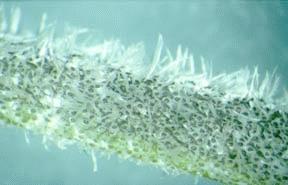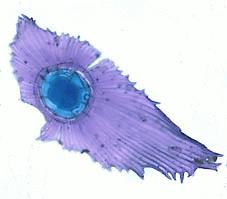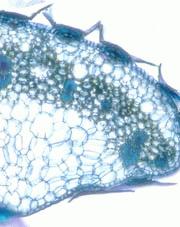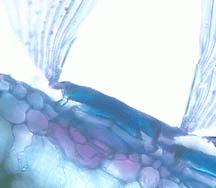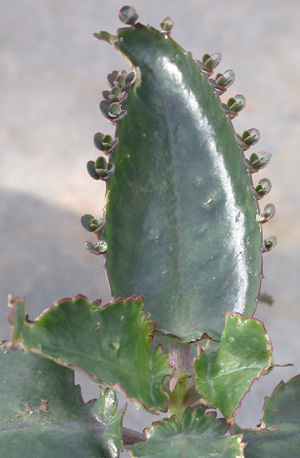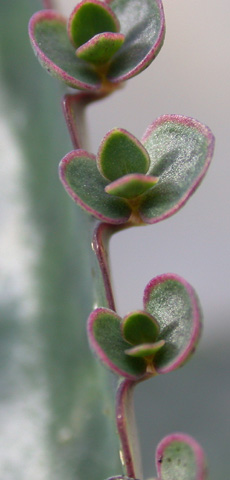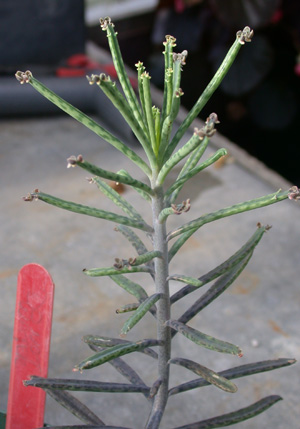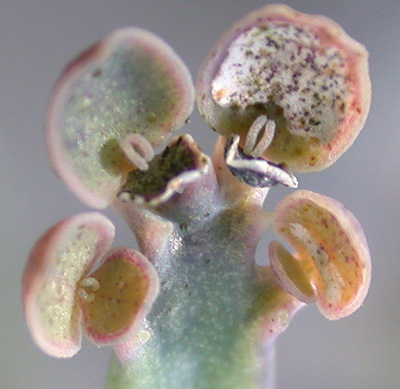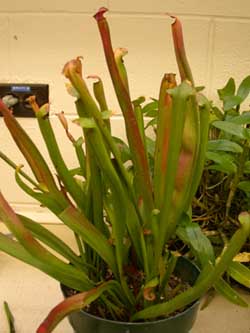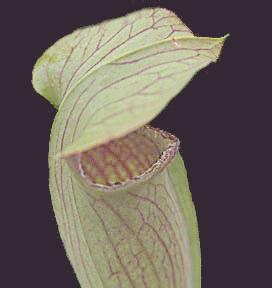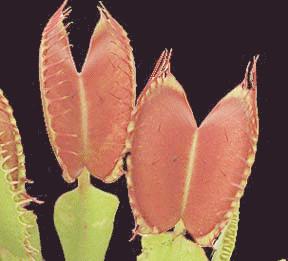LEAF MODIFICATIONS
Function – Storage
Organs which function in storage develop abundant parenchyma.
Peperomia
Peperomia is a lovely little houseplant that has a very interesting way of storing water.
This is a cross section of the Peperomia leaf. The clear area above the green mesophyll is made up of large, thin-walled parenchyma cells which make up the multiple epider
Aloe
This plant also stores water in the mesophyll of its leaves.
The juice of the aloe plant has been used to ease the pain of burns
When you cut a leaf off you can see that is is very juicy (and slimy).
This is a cross-section through the leaf of Aloe. Note the large parenchyma cells used for the storage of water. What type of habitat do think these plants live in? As one student learned in class, applying the slimy innards of the leaf to a burn is very soothing.
A close-up of a vascular bundle.
Function – Protection (includes leaves and stems)
Stems or leaves and the epidermis of either stem or leaf may form hard, sharp defensive structures (thorns, spines, prickles) which reduce a plant’s chances of being eaten by herbivores. The modified organ may be dead or living at maturity, and in either case will bear little resemblance to the organ it originated from. You may determine whether a defensive structure is a stem, leaf or epidermal modification by observing its location relative to the leaves. A stem will arise in a leaf axil (modified stem = thorn); stipules, which are leaf accessories, will be found at the base of leaves (modified leaf = spine); prickles (epidermal modifications) will arise randomly, without reference to leaf origins.
Citrus medicata thorns
The thorns of Citrus can be pretty treacherous looking!
Thorns arise at the axils of leaves and are therefore considered modified branches.
As further evidence of this you were asked to make a cross-section through a stem and through a thorn. Here is a picture through the cross-section throught the stem. Note the secondary vascular tissue (pith in the middle).
This is a picture of a cross-section through a thorn.
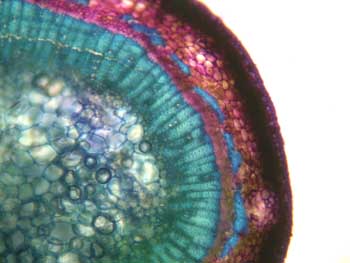 The cross-section on the right is a section through the thorn. You see also secondary vascular tissue. What would you expect to see if this was a prickle or part of a leaf?
The cross-section on the right is a section through the thorn. You see also secondary vascular tissue. What would you expect to see if this was a prickle or part of a leaf?
This is a good slide to review the tissue types and regions of a secondary stem. Before you continue see if you can identify the secondary xylem, secondary phloem, primary phloem, pith, cortex, and epidermis.
This is a great slide of the cross-section through a thorn…labeled too!!!!
Even thorns can have stomata!
Euphorbia (Crown-of-Thorns) spines
The sharp-pointed processes on Euphorbia emerge from the stem.
A pair of spines emerges at the base of each leaf, just as stipules would. These spines represent stipule (leaf) modifications.
Rubus discolor – blackberry
This weed is very prickly! It has prickles over its stems and petioles.
The prickles are actually a modification of the epidermis and have no vascular tissue within. Another clue is that they are randomly scattered over the stem; not associated with leaves or branches.
Acacia xanthophloea – fever tree
Note the position of the leaves relative to the defensive structures of this Acacia found in parts of Africa. Again we see two ‘spines’ associated with each leaf and therefore they represent modified bracts (leaves). Interestingly, this species (A. xanthophloea) is found in swampy areas where mosquitoes breed, and early settlers were convinced that the tree was the cause of malaria. This gave the common name ‘fever tree’.
[photo by Charlene Mason, 1998]
Opuntia
This cactus also has modified leaves which act as defence organs. The green modified stem is not only imporant because it is photosynthetic, but it is also important for storing water.
Acacia drepanolobium – whistling thorn
The common name for this plant is misleading – the defensive structures are not thorns, they’re spines. This species of Acacia has an additional protective mechanism. The plant forms galls (pictured here) naturally and ants make a small hole into these structures. The ants lay their eggs inside the galls and tend the larvae. In return for a daycare, the ants will attack the snout of any animal that tries to eat the plant, protecting it from harm.
[photo by Charlene Mason, 1998]
Function – Absorption
As we learned in earlier sections roots are important absorptive organs of most plants. Epiphytic plants however have developed other strategies. This tank bromeliad absorbs water through its leaf bases. Tank bromeliads make nice house plants. What many people don’t realize is that instead of watering this plant through the soil you should water it in its “tank”.
This is Tillandsia, another type of bromeliad. The leaves of this plant have modified trichomes which actually absorb water.
The surface of each leaf is covered in trichomes.
Each trichome is quite elaborate. This is a trichome which has been scraped off the leaf and stained with toluidine blue.
This is the cross-section through a leaf. You can see the trichomes. Note that they cover most of the leaf surface.
This is a section through the trichome. The part that sticks up from the leaf is called the shield. These are dead cells which not only absorb water, but prevent water loss by decreasing air currents over the surface of the leaves.
Function – Vegetative Reproduction
Vegetative (nonsexual) reproduction is widespread in plants. It is often accomplished without special modification of the plant organs. Stem sections and single leaves may grow roots and regenerate entire plants; rhizomes or roots are often able to sprout new shoots.
In some cases, however, vegetative reproduction is accomplished by unique modifications of certain organs, especially leaves. The leaves of some angiosperms (as well as some ferns) form plantlets at meristematic regions along their edges as a means of vegetative reproduction (see Raven 7th, p. 159; 8th, p. 171).
Kalanchoe (mother of thousands)
This plant produces little plantlets on the margins of the leaves.
Once the little shoot falls off and lands it will produce roots and become established as a little clone of its mother.
Bryophyllum
This plant also produces little plantlets.
NITROGEN DEFICIENCY
In some habitats nitrogen is not readily available to plants.
Some plants solve the problem of the lack of available nitrogen in a very aggressive fashion. The carnivorous, or insect-eating plants, have leaves modified to attract and trap animal prey and utilize animal proteins directly as a nitrogen source. As you look at the images of insectivorous plants think about how the leaves are modified to perform the functions of trapping and digestion.
Sarracenia
(Pitcher Plant)
The leaves of this plant are upright and flask-shaped.
Numerous nectar-secreting glands on the outer surface, and especially around the lip of the flask, serve to attract insects. The red or purple colouration of some flasks may also be attractive to insects. Once the insects enter the pitcher they are prevented from getting out by a combination of downward-pointing hairs and a slippery surface. Trapped insects eventually drown in fluid at the bottom of the pitcher, and are digested by enzymes secreted into the fluid.
Linda is finding a yummy morsel from inside the trap. I guess if you are a starving TA the little trapped bugs might be a treat!
Dionaea (Venus Flytrap)
Nectar is secreted on the leaf surface of the Flytrap. Each leaf has a broad petiole and a leaf blade of two halves, which are joined by a moveable hinge. The edges of the blade bear stiff bristles and in the middle of each half are three long trigger hairs. Check out this uber awesome video made by Kristina Balce.
When an insect touches the trigger hairs, the two halves quickly close and trap the insect. The movement is caused by differential cell enlargement on the outer leaf surface. As in the pitcher plant, digestive enzymes are then secreted, and nutrients are absorbed by the plant. Several days later the blade again opens, ready to trap another insect.
In addition to the trigger hairs, note the pink secretory cells on the leaf surface. These are the source of the enzyme which digests the trapped insect.
Drosera (Sundew)
Sundews are lovely little bog plants.
The surface of the Sundew leaf is covered with many tentacle-like hairs, each with a rounded glandular head and an internal strand of xylem. The gland secretes a sticky mucilage which is attractive to insects. When an insect becomes entangled by the mucilage, the tentacles bend inward. Nearby tentacles also bend towards the insect, as may the entire leaf, entrapping the prey. The movement of the tentacles, like the movement of the flytrap leaf, is the result of rapid differential cell enlargement.
Here is a longitudinal section through. A leaf with tentacles.
Utricularia vulgaris (Bladderwort)
This aquatic plant traps and digests insects and other organisms within small hollow bladders. The bladder entrance is covered by a door which is hinged at the upper edge and has stalked mucilage glands to produce attractive substances, and stiff bristles to act as a tripping mechanism. The bladder empties itself by excreting water, thus creating pressure on its walls from the water outside. When prey touches the bristles, the edge of the door opens a crack, allowing water to rush into the trap, carrying the helpless insect with it. Enzymes secreted within the bladder digest the insect. The walls of the bladder absorb the nutrients released.
Pinguicula (butterwort)
The leaves of this plant are slimy (hence the name “butterwort”). If you were to look at the leaf microscopically you would see two types of glands – those which produce a sticky substance (to catch the insect) and digestive glands (to release enzymes). The flowers are often borne a distance from the insect catching part of the plant…pretty smart! You wouldn’t want to eat your pollinators!
Some plants overcome nitrogen deficiency by developing symbiotic associations with nitrogen-fixing bacteria or cyanobacteria.
Azolla
This fern, Azolla, has a symbiotic association with the cyanobacterium Anabaena (Raven 7th, p. 398; 8th, p. 419).
Gunnera
Gunnera (elephant ear plant) has colonies of Nostoc (another cyanobacterium) living in the bases of its leaf petioles.
MESOPHYTES (there is no shortage of available water)
XEROPHYTES (dry habitat)
HYDROPHYTES (lots of water)
TRICHOMES AND LEAF APPENDAGES
LEAF MODIFICATIONS
BACK TO LEAF FRONTPAGE

